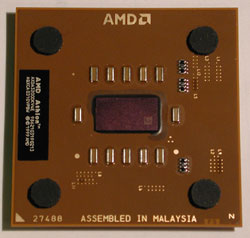|
|
Advertisement:
|
|
AMD AthlonXP 3200+ (Barton core, 400MHz FSB) |
|
Join the community - in the OCAU Forums!
|
Introduction, Chipsets, Testing Setup
In August last year, AMD were kind enough to send us a sample of their AthlonXP 2600+ CPU product for testing. Some 9 months later, we have received an AthlonXP 3200+ from Plus Corporation. The difference of 600 points on AMD's Performance Rating system and the timeframe involved had me assuming there would be a correspondingly large speed jump, in terms of MHz, between the 2600+ and this new 3200+. However, the 3200+ runs at 2200MHz - a mere 66MHz above the 2600+'s 2133MHz. Clearly, AMD feel that something other than sheer MHz warrants the sizeable jump in Performance Rating.
The most fundamental difference is that the 3200+ uses the new Barton core, the same .13 micron core as seen on AMD's 2500+, 2800+ and 3000+ products. This core is substantially wider than the Thoroughbred core seen on the 2600+ because there is more inside the core, namely an extra 256kB of L2 cache. This brings the AthlonXP to 512kB of full-core-speed L2 cache, on par with Intel's Pentium 4 product.

The other significant difference between this processor and earlier versions is the Front-Side Bus (FSB) speed. The Front-Side Bus is what connects the CPU internals to the rest of the system components. Very simplified, it's the speed that the CPU socket, where it plugs into the motherboard, runs at. More bandwidth here gives a high-speed CPU quicker access to the rest of the system, most importantly the main system memory. The AthlonXP uses a DDR FSB, which can lead to some confusion when describing the speed. For the remainder of this article I will refer to the "effective speed" of the FSB. For example, the 2600+ uses the 266MHz bus, which is really clocked at 133MHz but sends two signals per clock for an effective speed of 266MHz. The earlier Barton-cored AthlonXP CPUs have seen 333MHz FSB, but this 3200+ jumps ahead to 400MHz FSB. The low FSB speed of AMD's AthlonXP has often been blamed as the bottleneck, with the higher-speed, quad-pumped FSB of Intel's Pentium 4 praised as providing the P4's excellent memory bandwidth. In this review we will see how much real-world difference these changes make.
A few notes about the CPU package first. It's socket462, like all socketA Athlons and Durons. Voltage is 1.65v, the same as even an older Thoroughbred-cored CPU like 2200+. There have been rumours and photographs of a new bridge system on the CPU package which is presumably designed to make it harder to multiplier-unlock AthlonXP's - it wasn't present on this CPU, which is good news.
Benchmarking:
I thought it would be interesting to try and isolate the effects of the higher FSB and the larger L2 cache. I received this CPU on extremely short notice and only had it for a few days so unfortunately couldn't build a P4 testbed to compare it to. The AthlonXP 2600+ review from 9 months ago gave us an idea of how the flagship AMD and Intel CPUs compared at the time - pretty evenly overall. In the meantime we haven't seen one camp leap substantially ahead of the other. The performance crown swings like a pendulum back and forth between them, with small increments each time. This review will focus on how much real-world difference the new features of this processor make in comparison to its predecessors.
Testbed Setup:
AMD AthlonXP 3200+ OR AMD AthlonXP 2200+ CPU (from PlusCorp)
OCZ Gladiator II CPU Cooler (from David and Karma)
ABIT NF7-S v2.0 nForce2 Motherboard (from SecretNet)
OCZ Enhanced Latency PC3500 512MB DDR memory (slot 3) (from David and Karma)
Corsair XMS3500C2 512MB DDR memory (slot 2) (from Altech)
Gigabyte Radeon 9800 Pro video card (from PlusCorp)
Antec TruePower 550W PSU (from Altech)
A note on motherboard chipsets: PlusCorp originally sent Gigabyte's 7VAXP-A Ultra KT400A-based motherboard to test with this CPU. Curiously, this seems to be something of an orphan on Gigabyte's site, not rating a mention on their motherboard products page while the older, KT400 non-A version does. In the last few days we've seen Gigabyte announce their nForce2-based motherboard while VIA have announced their KT600 chipset. It leaves me wondering where this KT400A motherboard - indeed, where any KT400A motherboard - fits into the market. Gigabyte have this product but it's the only shipping KT400A board. I believe AOpen, MSI and some others have announced KT400A boards, but I wonder if they will really make it to retail stores. KT400A seems to be an interim product that has been superceded before it even got off the ground.
Anyway, I couldn't make the XP3200+ work stably at 400MHz FSB on this board because it lacks a /6 divisor for AGP and PCI, meaning at 400MHz FSB they were at 80MHz and 40MHz respectively. I could turn off UDMA on the hard drives so they'd cope with the high PCI speed, but I couldn't make a video card work stably on that high an AGP speed despite trying a few tweaks. Eventually I switched to the nForce2 motherboard which coped fine and had AGP and PCI at stock speeds (66MHz and 33MHz respectively) at 400MHz FSB.
|
|
Advertisement:
All original content copyright James Rolfe.
All rights reserved. No reproduction allowed without written permission.
Interested in advertising on OCAU? Contact us for info.
|

|


